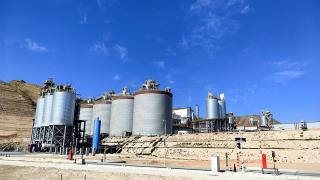The formation of cracks in concrete is a common occurrence and in many cases is not regarded as a major issue. However, in some circumstances they may pose a threat to a concrete structure if its purpose is to prevent the movement of water or if there is a risk of the ingress of deleterious materials. Research is underway in a number of locations to investigate ways of encouraging healing of the cracks without major intervention.
A characteristic of Portland cement is its high content of calcium oxide (CaO). In nearly every case this CaO originated as calcium carbonate (CaCO3) in limestone. The process of producing clinker involves heating the limestone in the presence of other materials containing silica (SiO2), iron oxide (Fe2O3) and alumina (Al2O3) so that the CaCO3 loses the CO2 part of its constitution and the remaining CaO combines with the other oxides to form the compounds we know in clinker as alite (tricalcium silicate), belite (dicalcium silicate), aluminate (tricalcium aluminate) and ferrite (tetracalcium alumino-ferrite) phases. The exact stoichiometry of these phases varies, sometimes quite appreciably, from the chemical analyses implied by the names in brackets.
